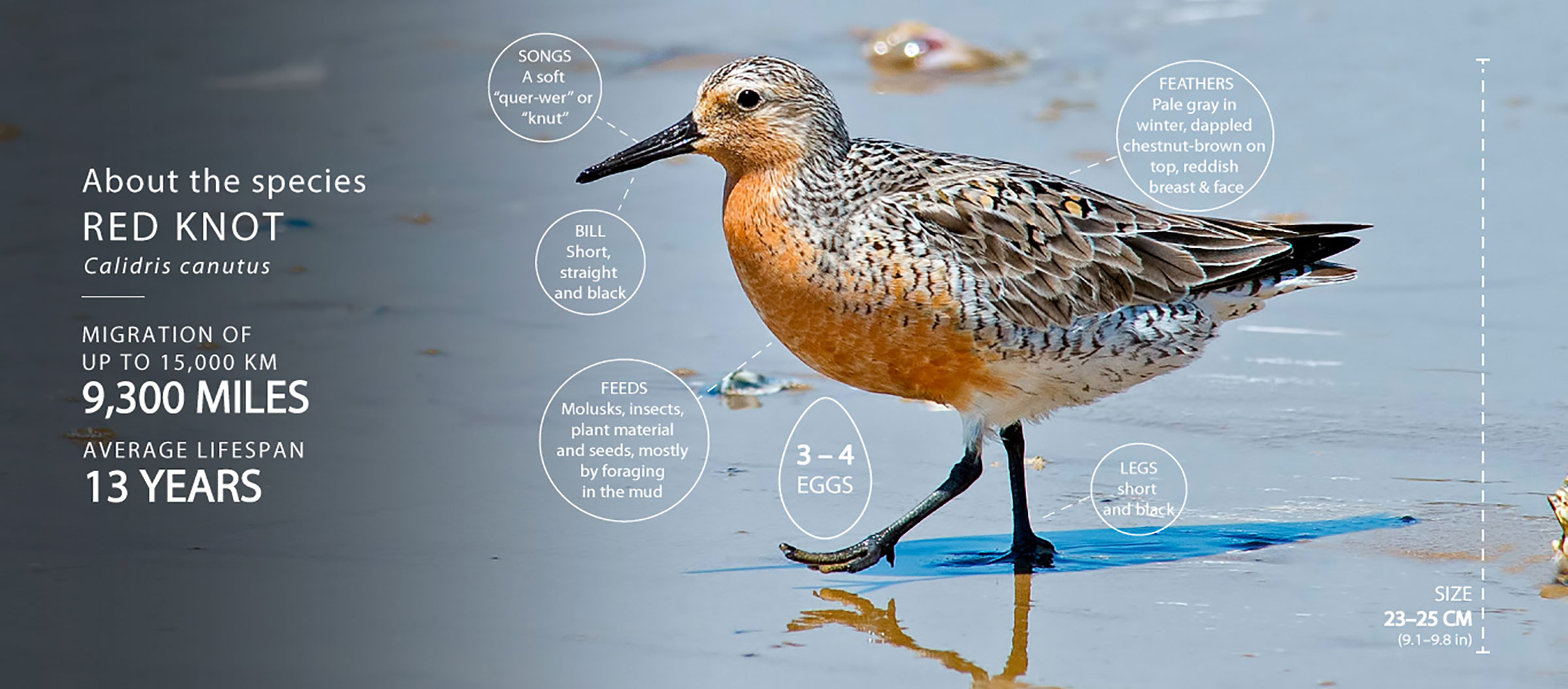Red Knot
Weighing about as much as a D-size battery, Red Knots fly up to 15,000 km (9,300 miles) during their yearly migration between Arctic breeding grounds and wintering grounds farther south, which for some Red Knots is the southern tip of South America.

Infographic: Commission for Environmental Cooperation
Population
Two subspecies of Red Knot migrate across North America. The estimated population of the roselaarisubspecies is 21,770 individuals.1The estimated population of the rufasubspecies is 42,000 individuals.2
In the past decades, rufa and roselaari Red Knots have experienced population declines.3,4,11 The rufa subspecies is listed as threatened under the Endangered Species Act in the United States; rufa and roselaari subspecies are listed as Endangered and Threatened, respectively, under Schedule 1 of the Canadian Species at Risk Act; and the roselaari subspecies is listed as Threatened in Mexico.
Habitat
Red Knots breed in drier tundra areas,5making their nests in an open, shallow depression.6 During the non-breeding season, Red Knots are found in coastal and intertidal areas.5
How to identify?
In spring, look for breeding males’ rusty chestnut–colored chest and belly and blackish-pale/rufous-chestnut back.3 Breeding females have light-colored and white feathers amidst the plumage of the belly. Adults measure about 23–25 cm, have quite short and straight, tapered black bills, and short and thick black legs. In winter, non-breeding adults are pale-gray and white.
Migration
The roselaari subspecies migrates along the Pacific Coast from northwestern Alaska and Wrangel Island to California and northwestern Mexico. The rufasubspecies migrates from the Eastern Canadian Arctic to Florida, Mexico and South America. However, there is increasing recognition that there are four separate biogeographic populations within rufa subspecies, with discrete wintering areas and migration strategies;7the population with the longest migration route winters in southernmost South America (primarily Tierra del Fuego).
Diet
Breeding Red Knots feed mostly on insects, as well as spiders, small crustaceans, snails and worms,8 although they also feed on plant material when they arrive in the Arctic and insects are scarce.9. In the non-breeding season, they feed on crustaceans, small snails and mollusks.5 At stopover sites such as Delaware Bay along the east coast of the United States, rufa Red Knots feed on large quantities of horseshoe crab eggs to refuel for their long migrations.
SOURCES
1 Lyons, J.E., W.L. Kendall, J.A. Royle, S.J. Converse, B.A. Andres, and J.B. Buchanan. 2015. Population size and stopover duration estimation using mark-resight data and Bayesian analysis of a superpopulation model. Biometric 72(1): 262–271.
2 Andres, B.A., P.A. Smith, R.I.G. Morrison, C.L. Gratto-Trevor, S.C. Brown, and C.A. Friis. 2012. Population estimates of North American shorebirds. Wader Study Group Bulletin 119(3): 178–194.
3 BirdLife International. 2017. Calidris canutus (amended version published in 2016). The IUCN Red List of Threatened Species 2017: e.T22693363A111379432. Online at: <http://dx.doi.org/10.2305/IUCN.UK.2017-1.RLTS.T22693363A111379432.en>. Downloaded on 25 July 2017.
4 Government of Canada. 2017. Species profile (Red Knot roselaari type). Species at Risk Public Registry. Online at: < http://www.registrelep-sararegistry.gc.ca/species/speciesDetails_e.cfm?sid=982>. Accessed on 25 July 2017.
5 The Cornell Lab of Ornithology. 2017. All About Birds online bird guide. Red Knot. Online at: <www.allaboutbirds.org/guide/Red_Knot>. Accessed on 25 July 2017.
6 Flint, V.E., R.L. Boehme, Y.V. Kostin, and A.A. Kuznetsov. 1984. A field guide to birds of the USSR. Princeton, New Jersey: Princeton University Press.
7 Commission for Environmental Cooperation. 2017. Identification of important Semipalmated Sandpiper and Red Knot sites along the North American Atlantic and Pacific flyways. Montreal, Canada: Commission for Environmental Cooperation: 4.
8 del Hoyo, J., A. Elliott, and J. Sargatal. 1996. Handbook of the birds of the world, vol. 3: Hoatzin to auks. Barcelona, Spain: Lynx Edicions.
9 National Audubon Society. 2017. Guide to North American birds. Red Knot. Online at: <www.audubon.org/field-guide/bird/red-knot>. Accessed on 25 July 2017.
10 Environment and Climate Change Canada. 2016. Recovery strategy and management plan for the Red Knot (Calidris canutus) in Canada [Proposed]. Species at Risk Act Recovery Strategy Series. Ottawa: Environment and Climate Change Canada, ix + 54 pp.
11 Government of Canada. 2017. Species profile (Red Knot rufa type). Species at Risk Public Registry. Online at: <http://www.registrelep-sararegistry.gc.ca/species/speciesDetails_e.cfm?sid=980>. Accessed on 25 July 2017.
Red Knot Photos: Brad Winn.





